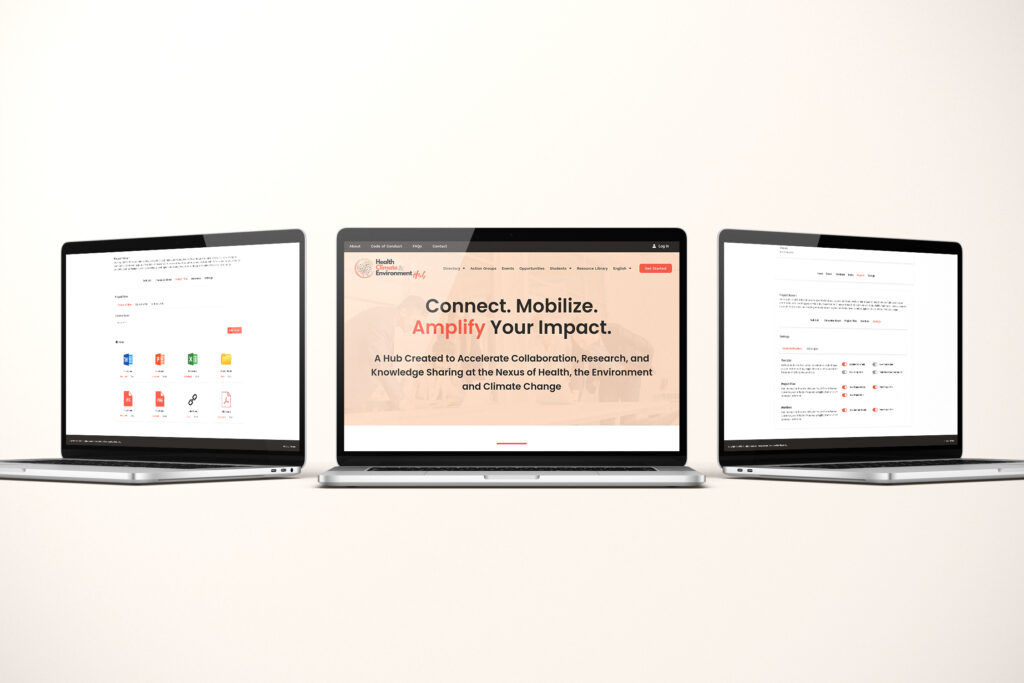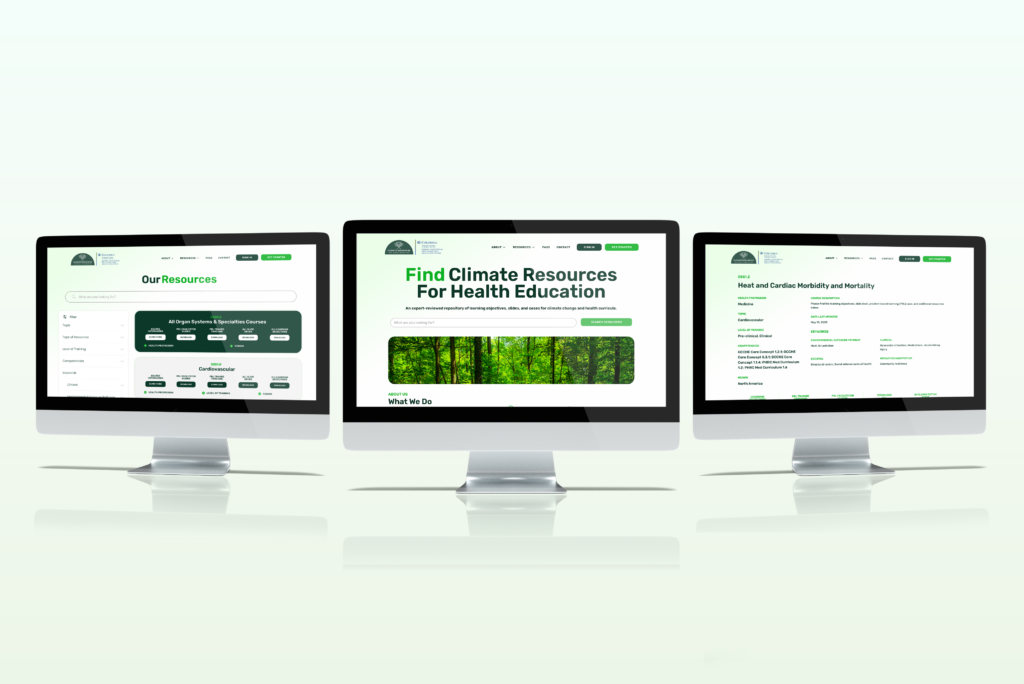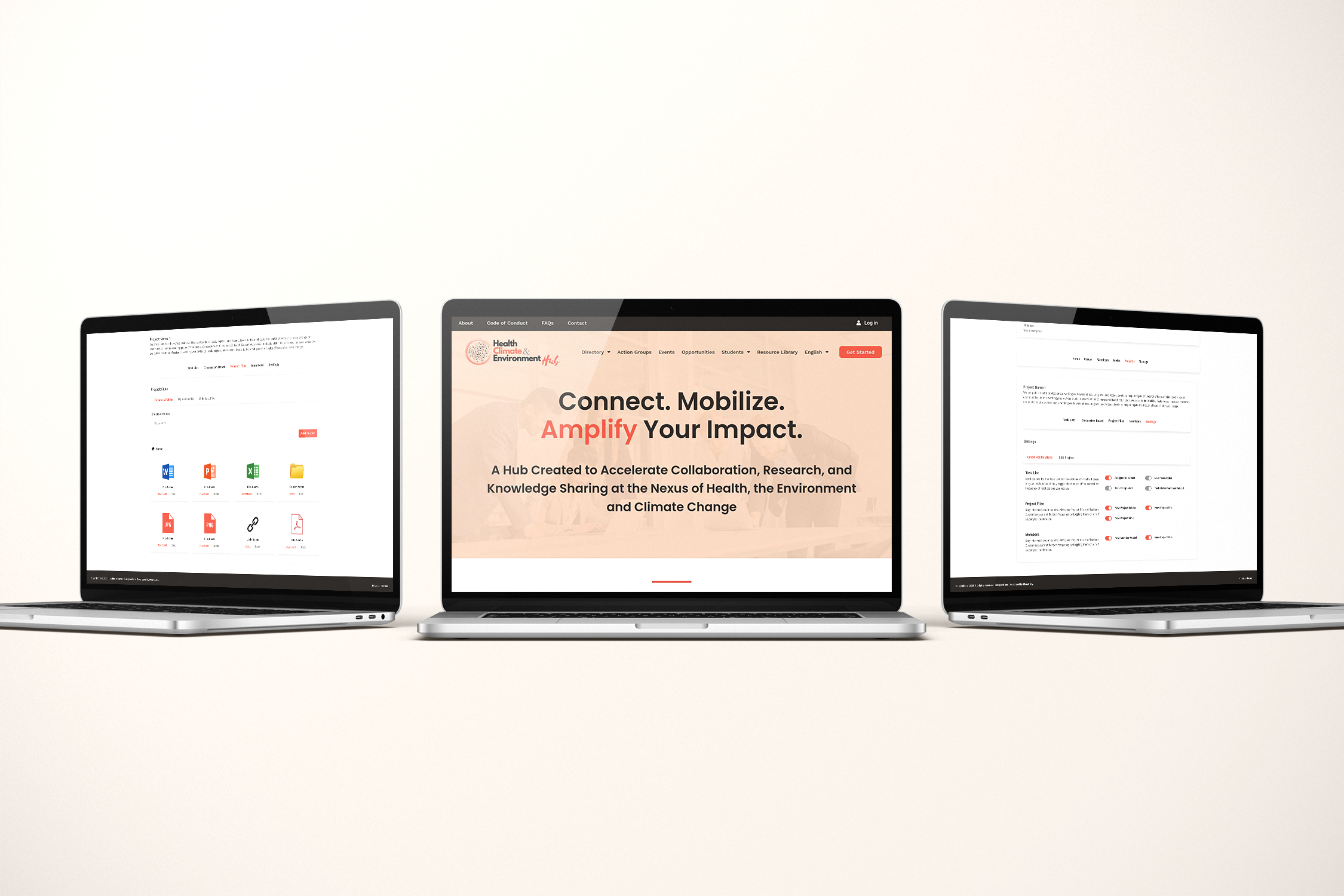Case Study
Agape Acts
An Inspirational App for Inspiring Kindness and Building Community
Project Overview
Project Scope
Tools
Stakeholders
Duration
Role
Project Scope
Tools
Stakeholders
Duration
Role
Background
The Agape Acts case study focuses on the UX design process of creating an innovative and empowering mobile application. Agape Acts is a platform designed to celebrate and recognize acts of kindness and generosity in our world. The goal of the project was to develop a user-centered app that fosters a positive and supportive community, encourages kindness, and inspires others to make a difference. To kickstart the project, extensive market research was conducted to gain a comprehensive understanding of the market landscape, audience demographics, and emerging trends. This research provided valuable insights into the target audience, their needs, and the gaps in existing solutions.
Based on the research findings, provisional personas were created to represent potential users of Agape Acts. These personas helped identify suitable individuals for interviews and understand their goals and needs deeply. User interviews were conducted to gather insights, frustrations, and aspirations directly from the target audience. Using the gathered data, empathy maps were created to empathize with the users, understand their experiences, and uncover key insights and needs. These insights guided the formulation of the project’s goals and the creation of meaningful questions for further research.
The project goals and user needs were then translated into actionable Point-of-View (POV) statements and How-Might-We (HMW) questions, which served as a foundation for ideation and solution brainstorming sessions.
Throughout the UX design process, the team iterated on ideas, incorporating user feedback, and aligning with the business goals. The final design solutions included features such as story sharing, recognition walls, community forums, and curated resource libraries, all aimed at facilitating acts of kindness, inspiring connection, and fostering a supportive community. The case study demonstrates the significant role of user research, empathy, and iterative design in developing an impactful app like Agape Acts. It highlights how the UX design process was instrumental in comprehending user needs, uncovering design possibilities, and ultimately delivering a user-centered solution that aligns seamlessly with the project’s objectives.
Challenges
Designing a Positive and Supportive Community: One of the key challenges is creating a digital environment that fosters positivity, support, and inspiration. The app should encourage users to engage in meaningful interactions, share stories, and applaud acts of kindness.
Promoting User Engagement: To ensure the success of the app, it is important to design features and interactions that encourage users to actively participate and engage with the platform regularly. This could involve creating incentives, rewards, or gamification elements to keep users motivated.
Balancing Recognition and Privacy: While the app aims to recognize and celebrate acts of kindness, it’s crucial to find a balance between recognizing individuals and respecting their privacy. Ensuring that users feel comfortable sharing their stories while maintaining their privacy will be a challenge.
Ensuring Authenticity and Accountability: Since the app relies on user-generated content and nominations, it is important to establish mechanisms to verify the authenticity of acts of kindness and prevent misuse or false nominations. This can be a challenge when dealing with subjective experiences and narratives.
Encouraging Offline Engagement: While the app provides opportunities to give back to local communities, it will be important to design features that seamlessly bridge the gap between the digital platform and real-world actions. Encouraging users to translate their digital engagement into tangible acts of kindness may require thoughtful design considerations.
Objectives
- The primary objective is to design an app that fosters a vibrant community centered around kindness, support, and inspiration. The app should provide a safe and encouraging space for users to connect, share stories, and applaud acts of kindness.
- The app should enable users to nominate and recognize individuals or groups who have displayed exceptional acts of kindness. It should facilitate the sharing of compelling stories, videos, and images to highlight the positive impact of these acts.
- The app should allow users to express gratitude and appreciation by giving Agape Tokens to those who have performed acts of kindness. These tokens serve as a tangible way of recognizing and valuing selfless contributions.
- The app should include features and mechanisms to encourage regular user engagement. This could involve gamification elements, rewards, badges, or other incentives to motivate users to actively participate and contribute to the community.
- In addition to recognizing acts of kindness, the app should provide users with opportunities to give back to their local communities. It should offer a curated list of volunteering or donation opportunities, allowing users to contribute their time and efforts to meaningful causes.
- The app should implement mechanisms to verify the authenticity of acts of kindness and nominations, ensuring that the community maintains trust and integrity. This could involve user feedback, moderation, or other validation processes.
- The ultimate objective is to create a movement that inspires individuals to make a positive difference in the world. The app should serve as a catalyst for kindness, gratitude, and compassion, inspiring users to act and contribute to a brighter future.
Design Process
From Concept to Creation
Hypothesis
Strategy
Build
Discover
Discover
Define
Develop
Deliver
Discover
- Requirement Analysis
- Stakeholder Interview
- User Feedback Analysis
- Iterative Design Improvements
- A/B Testing and Experimentation
- Optimization
Research Plan
Discover
Research Goals
- Gain a deep understanding of the target users’ motivations, behaviors, and needs related to acts of kindness, recognition, and community engagement.
- Identify potential barriers or challenges that users may face when participating in the Agape Acts app.
- Test and validate assumptions about user preferences, expectations, and the overall user experience of the app.
- Gather insights on how to effectively encourage and sustain user engagement within the Agape Acts community.
- Understand users’ perceptions of privacy and the balance between recognition and anonymity.
- Explore opportunities for offline engagement and the integration of real-world actions within the app.
Research Questions
- What motivates users to engage in acts of kindness and participate in a community-focused app like Agape Acts?
- What are the existing frustrations or challenges users encounter when recognizing acts of kindness or expressing gratitude?
- What are users’ expectations and preferences regarding the process of nominating and recognizing acts of kindness?
- How do users perceive privacy concerns and what level of anonymity do they expect when sharing stories or engaging with others?
- What incentives or gamification elements would encourage users to actively participate and engage with the Agape Acts app on a regular basis?
- How can the app effectively bridge the gap between digital engagement and offline actions in the community?
- What features or functionalities would users find valuable in terms of discovering and engaging with volunteering opportunities?
Assumptions
- Users are motivated to engage in acts of kindness and recognize others for their selfless actions.
- Users value recognition and appreciation for their acts of kindness and seek a platform to share their stories.
- Users are willing to participate in a digital community centered around acts of kindness and want to connect with like-minded individuals.
- Users expect a user-friendly and intuitive interface for nominating and recognizing acts of kindness.
- Users are open to sharing personal stories, videos, and images related to acts of kindness, but also have concerns about privacy and anonymity.
- Users are more likely to engage with the app if there are incentives, rewards, or gamification elements that motivate their participation.
- Users are interested in opportunities to contribute offline and engage in real-world acts of kindness through the app’s curated list of initiatives and volunteering opportunities.
Methodologies
User Interviews: Conduct in-depth interviews with a diverse group of potential users to gather qualitative insights into their motivations, expectations, concerns, and preferences. Use semi-structured interview guides to explore the research questions in detail.
Surveys: Design and distribute online surveys to a broader audience to collect quantitative data on user preferences, attitudes, and willingness to engage in different activities within the app.
Usability Testing: Perform usability tests with prototypes or early versions of the app to observe how users interact with the interface, identify usability issues, and gather feedback on specific features and interactions.
Focus Groups: Conduct focus groups with users who have experience with acts of kindness, community engagement, or recognition initiatives to facilitate discussions on relevant topics and gather collective insights.
Comparative Analysis: Analyze existing apps or platforms that focus on recognition, community engagement, or giving back to identify successful features, trends, and potential areas for improvement.
Participants
Participants for the research activities can include:
- Individuals who have performed acts of kindness
- Individuals who appreciate and recognize acts of kindness
- Users interested in community engagement and making a positive impact
- Individuals from diverse age groups
- Individuals from diverse cultural backgrounds
- Users with varying levels of tech proficiency
- Both frequent and occasional app users
- Users who have used similar recognition or community-focused apps in the past
Project Timeline
Tasks
Timeframe
Market Research
Discover
Conducting market research is crucial to gain a comprehensive understanding of the market landscape, including audience demographics, knowledge gaps, emerging trends, and recent news. These insights inform the creation of provisional personas and guide the formulation of meaningful questions for primary research.
Market Trends
Growing Interest in Kindness and Well-being: There has been a noticeable shift in societal attitudes towards kindness, well-being, and the importance of mental health. People are increasingly seeking ways to promote positivity and make a difference in their communities. This trend is reflected in the popularity of apps and platforms that focus on acts of kindness, recognition, and community engagement.
Rise of Social Impact Initiatives: There is a growing emphasis on social impact and corporate social responsibility (CSR) across various industries. Many companies and organizations are actively seeking ways to give back to their communities and make a positive difference. This trend presents an opportunity for Agape Acts to collaborate with businesses and organizations looking to engage their employees and stakeholders in acts of kindness and community initiatives.
Gamification and Rewards for Positive Behavior: The use of gamification techniques and rewards to motivate and engage users has gained significant traction in various applications. By incorporating elements such as tokens, badges, and achievement systems, Agape Acts can tap into this trend to incentivize and reinforce positive behavior. Gamification can enhance user engagement, encourage repeat interactions, and create a sense of achievement and progress.
Trends and Considerations
Increased Emphasis on Mental Health and Well-being: There is a growing recognition of the importance of mental health and well-being in society. Individuals are actively seeking ways to improve their emotional and mental state and acts of kindness can play a significant role in promoting positive well-being. Agape Acts can position itself as a platform that not only recognizes acts of kindness but also highlights the positive impact they have on the mental health and happiness of both recipients and givers.
Integration of Social Media and Sharing Culture: The widespread use of social media platforms has created a culture of sharing personal stories, experiences, and achievements. Agape Acts can leverage this trend by providing seamless integration with popular social media platforms, enabling users to easily share stories, videos, and images of acts of kindness with their networks. This integration can amplify the reach and impact of the app, encouraging more individuals to participate in acts of kindness and inspiring others to join the movement.
Diversity, Inclusion, and Global Perspectives: Agape Acts should consider the importance of diversity, inclusion, and global perspectives in its design and content. Acts of kindness and generosity occur across different cultures, communities, and regions, and the app should reflect and celebrate this diversity. Including multilingual support, showcasing a variety of cultural and global stories, and providing opportunities for users to connect with individuals from different backgrounds will help create an inclusive and engaging experience for a wider audience.
Demographics
Age Range: The target audience for Agape Acts is likely to span across various age groups, but there may be variations in their motivations and preferences. The primary age range could be between 25 and 45 years, as this group often seeks ways to make a positive impact and actively engage in acts of kindness. However, it’s important to consider the potential for users from younger generations, such as Gen Z (born between 1997 and 2012), who have demonstrated a strong interest in social causes and community engagement.
Urban Dwellers: Agape Acts is likely to attract users primarily from urban areas, where communities are more diverse and opportunities for acts of kindness are abundant. Urban dwellers tend to have a higher exposure to social issues and may be more receptive to initiatives that promote positive change. However, it’s essential to consider users from suburban and rural areas as well, as acts of kindness can occur in any community.
Tech-Savvy Individuals: The target audience for Agape Acts is likely to consist of individuals who are comfortable using mobile applications and engaging in online communities. These individuals may have varying levels of technological proficiency, ranging from tech enthusiasts to casual users. Designing the app with user-friendly and intuitive interfaces will be crucial to ensure accessibility for users with different technological backgrounds.
Consumer Behavior
Increasing Desire for Meaningful Connections: Consumers today are seeking authentic and meaningful connections with others. They want to be part of communities that share their values and provide opportunities for positive engagement. Agape Acts can tap into this consumer behavior by fostering a supportive and uplifting community where users can connect, share stories, and recognize acts of kindness. Providing features that encourage meaningful interactions and facilitating genuine connections among users will resonate with this consumer behavior.
Desire for Personal Impact and Empowerment: Consumers are increasingly looking for ways to make a tangible impact and contribute to causes they care about. Agape Acts can align with this behavior by providing opportunities for users to give back to their local communities through curated initiatives and volunteer opportunities. Empowering users to act and highlighting the impact of their contributions will enhance their sense of fulfillment and engagement with the app.
Influence of Social Proof and Peer Recommendations: Consumers often rely on social proof and peer recommendations when making decisions. In the context of Agape Acts, users may be influenced by the recognition and appreciation shown to acts of kindness by their peers. Highlighting success stories, showcasing the impact of recognized individuals, and encouraging users to share their own experiences can create a sense of social validation and inspire others to participate in acts of kindness.
Competitive Analysis
Discover



LinkedIn is a professional networking platform that connects professionals from various industries. It allows users to create professional profiles, connect with colleagues and peers, and share industry-related content. While not directly focused on acts of kindness, it provides a platform for professional recognition and networking.
Strengths
Real-Time Updates: Twitter’s real-time nature makes it a platform for spreading timely information and raising awareness about acts of kindness and charitable initiatives.
Amplification and Engagement: Users can easily retweet and engage with tweets related to acts of kindness, allowing for wider visibility and potential viral reach.
Hashtags and Trends: Twitter’s use of hashtags and trends can help in organizing and tracking discussions related to acts of kindness, making it easier for users to discover and engage with relevant content.
Strengths
Visual Storytelling: Instagram’s focus on visual content allows users to share impactful stories through images and videos, making it an effective platform for showcasing acts of kindness.
Engaging Community: The platform’s user-friendly interface and interactive features, such as comments and likes, foster a sense of community and support.
Broad User Base: Instagram has a large and diverse user base, offering opportunities for reaching a wide audience and inspiring others with acts of kindness.
Strengths
Professional Networking: LinkedIn offers a robust platform for professionals to connect and build relationships, which can indirectly lead to recognition and opportunities for acts of kindness within professional contexts.
Industry Expertise: The platform provides access to a wide range of industry-specific knowledge and expertise, allowing users to contribute to discussions and share insights within their respective fields.
Established User Base: LinkedIn has a large and active user base, providing opportunities for networking and reaching a diverse professional audience.
Weaknesses
Limited Space for In-Depth Content: The character limit for tweets can restrict the depth of storytelling and sharing detailed stories of acts of kindness, potentially limiting the impact and emotional resonance.
Lack of Structured Recognition Features: Twitter does not have specific features for recognizing acts of kindness or providing formalized appreciation, which may make it harder to track and acknowledge individual acts.
Weaknesses
Lack of Dedicated Recognition Features: Instagram does not have specific features designed for recognizing acts of kindness or providing structured appreciation, which may limit the ability to track and amplify such acts.
Potential for Superficial Engagement: Due to the emphasis on visual content and popularity metrics (likes, followers), there may be a risk of users focusing more on aesthetics and popularity rather than the substance of acts of kindness.
Weaknesses
Limited Focus on Acts of Kindness: LinkedIn’s primary focus is on professional networking and career development, with less emphasis on acts of kindness or recognition outside of professional contexts.
Less Personalization for Acts of Kindness: The platform does not have specific features or tools dedicated to recognizing acts of kindness, which may limit opportunities for users to engage in this aspect.
Provisional Personas
Discover

Name
Kindness Advocate
Description
Socially Conscious
Age Range
25-34
Lifestyle
- Engaged in acts of kindness and community initiatives.
- Active on social media and passionate about making a positive impact in the world.
- Seeks opportunities to connect with like-minded individuals.
Goals
Recognize and Appreciate Kindness: Wants to acknowledge and appreciate acts of kindness to create a culture of positivity.
Connect and Inspire: Aims to connect with a community of individuals who share the same values and inspire others to engage in acts of kindness.
Pains
- Easy-to-use app interface to navigate and participate in acts of kindness.
- Features for sharing and showcasing acts of kindness stories with others.
- Tools for tracking personal acts of kindness and witnessing the impact made.

Name
Empathy Educator
Description
Educator or Teacher
Age Range
35-44
Lifestyle
- Works in the education field, passionate about fostering empathy and kindness in students.
- Seeks resources and tools to incorporate acts of kindness and empathy-building activities in the classroom.
- Values collaboration and networking with fellow educators.
Goals
Promote Empathy and Kindness in Education: Wants to integrate acts of kindness and empathy into the curriculum to create a compassionate learning environment.
Professional Development: Seeks opportunities to enhance their knowledge and effectiveness in teaching empathy and kindness.
Pains
- Access to evidence-based resources and lesson plans to incorporate acts of kindness and empathy in education.
- Collaboration and networking features to connect with other educators and share best practices.
- Professional development opportunities focused on empathy and kindness education.

Name
Community Connector
Description
Community Organizer or Activist
Age Range
45-54
Lifestyle
- Actively involved in community initiatives and passionate about creating positive change.
- Engages in acts of kindness and encourages community members to participate.
- Seeks opportunities for collaboration and amplifying acts of kindness within the community.
Goals
Amplify Acts of Kindness: Aims to bring recognition and appreciation to acts of kindness in the community.
Mobilize and Engage the Community: Seeks tools to mobilize community members, foster collaboration, and inspire collective action.
Pains
- Tools for organizing and promoting community events and initiatives related to acts of kindness.
- Collaboration features to connect with like-minded individuals and organizations.
- Opportunities to share stories of impactful acts of kindness and inspire others.
User Interviews
Discover
Interview Questions
Assumptions Validated
Assumption
Validation
Empathy Map
Discover
Insight
Need
Users recognize acts of kindness as a means of positive community development and want to integrate kindness into educational curricula.
User Personas
Discover
Understanding the audience is a crucial aspect of the UX design process for Agape Acts. By gathering extensive knowledge about the audience, including their goals and needs, user personas were created to represent key audience segments. These personas serve as fictional yet realistic representations of the target users, enabling the design team to focus on addressing the most important problems and fulfilling the major needs of the most significant user groups.

Name
Sophia Chen
Age
34
Occupation
High School Science Teacher
Marital Status
Married
Location
Boston, Massachusetts
Archetype
Sophia leads a busy life, juggling work commitments, community engagements, and personal interests. As a passionate educator, she spends time researching and developing innovative teaching approaches. She attends workshops and conferences related to climate change education to enhance her professional knowledge and network with like-minded individuals. Sophia also enjoys outdoor activities and actively participates in local environmental initiatives.
Goals
Incorporate Climate Change in Curricula: Sophia wants to find evidence-based resources that can help integrate climate change and planetary health information into educational curricula, especially for schools and community programs.
Stay Up-to-Date: Sophia’s goal is to stay informed about the latest research, policies, and best practices in climate change and health education to enhance her teaching effectiveness.
Frustrations
Limited Time: Sophia faces time constraints due to her teaching responsibilities, making it challenging to research and develop comprehensive curriculum materials.
Lack of Centralized Platform: Sophia finds it difficult to navigate through various websites, databases, and publications to find relevant and reliable resources.
Needs
Accessible Resources: Sophia needs easily accessible and user-friendly resources that provide practical insights on incorporating climate change into curricula.
Collaboration Opportunities: Sophia seeks platforms that facilitate collaboration and networking with other educators and professionals in the field.
Motivations
- Making a positive impact on students’ understanding of climate change and health
- Shaping environmentally conscious individuals
- Contributing to a sustainable future

Name
Linda Hamilton
Age
40
Occupation
Community Health Educator
Marital Status
Divorced
Location
Seattle, Washington
Archetype
Change Agent
Linda is dedicated to her role as a community health educator, actively involved in developing curriculum materials, conducting research, and organizing field trips to enrich her students’ learning experiences. She frequently attends conferences and workshops to stay updated on the latest advancements in climate change and health education. In her free time, Linda enjoys outdoor activities and volunteers for local environmental organizations.
Goals
Engaging Educational Resources: Linda seeks engaging, age-appropriate, and scientifically accurate resources to teach her students about the impact of climate change on health and inspire them to act.
Collaboration Opportunities: Linda wishes to connect with other educators, researchers, and professionals to exchange ideas, share lesson plans, and collaborate on developing innovative teaching approaches.
Frustrations
Limited Time for Resource Development: Linda faces time constraints in developing comprehensive teaching materials that incorporate climate change and health topics, often relying on fragmented or outdated resources.
Keeping Up with Evolving Science: Linda struggles to stay up to date with the rapidly evolving research and best practices in climate change and health education.
Needs
Accessible Resources: Linda needs resources that are easily accessible and provide engaging, age-appropriate content on the impact of climate change on health.
Collaboration Tools: Linda seeks platforms that facilitate collaboration and networking with other educators and professionals in the field of climate change and health education.
Motivations
- Linda’s passion for empowering individuals and communities drives her to make a positive impact on their health and the environment.
- She believes that education is a powerful tool for fostering positive behavioral changes and addressing climate-related health challenges.
- Linda is motivated by the opportunity to inspire her students and instill in them a sense of responsibility towards their own well-being and the planet.

Name
James Kingsford
Age
58
Occupation
Public Health Officer
Marital Status
Married
Location
New York City, New York
Archetype
Visionary Leader
Sophia leads a busy life, juggling work commitments, community engagements, and personal interests. As a passionate educator, she spends time researching and developing innovative teaching approaches. She attends workshops and conferences related to climate change education to enhance her professional knowledge and network with like-minded individuals. Sophia also enjoys outdoor activities and actively participates in local environmental initiatives.
Goals
Policy Development: James aims to influence public health policies and initiatives that address the health impacts of climate change and promote sustainable practices.
Advocacy and Awareness: James seeks to raise awareness about the connections between climate change and health among policymakers, community leaders, and the public.
Frustrations
Limited Buy-in: James faces challenges in getting stakeholders to recognize the urgency and importance of integrating climate change considerations into public health policies and practices.
Resistance to Change: James encounters resistance from individuals and organizations who are hesitant to embrace sustainable practices or allocate resources to address climate-related health issues.
Needs
Research and Evidence: James requires access to research and evidence that demonstrates the health impacts of climate change, as well as the effectiveness of interventions and policies.
Collaboration and Networking: James seeks opportunities to collaborate and network with other public health officials, researchers, and policymakers working on climate change and health-related initiatives.
Motivations
- James is driven by his vision of a healthier and more sustainable future.
- He strongly believes that addressing climate change is essential for protecting public health and creating resilient communities.
- James is motivated by the opportunity to contribute to positive change by promoting awareness, education, and action on climate change and its impact on health.
- He is passionate about advocating for policies and practices that prioritize the well-being of both individuals and the planet.
Statements and Questions
Define
Insight
Need
POV Statement
HMW Question
How might we create a centralized and user-friendly platform that offers educators and health professionals practical resources to seamlessly integrate climate change topics into their curricula?
Educators and health professionals are eager to connect with like-minded individuals and share knowledge, seeking a collaborative platform that fosters networking and resource-sharing opportunities.
How might we develop a networking and collaboration feature that enables educators and health professionals to connect, exchange ideas, and share best practices in integrating climate change education into their teaching?
Educators and health professionals face challenges in integrating climate change education due to time constraints and varying educational contexts, requiring flexible and customizable resources.
How might we design adaptive and customizable resources that cater to diverse educational settings and allow educators and health professionals to tailor content based on their specific audience needs and available resources?
Users recognize acts of kindness as a means of positive community development and want to integrate kindness into educational curricula.
Educators and health professionals value evidence-based information and seek a reliable platform that offers the latest research and best practices on climate change and its impact on health.
How might we curate and verify content on the platform to ensure educators and health professionals have access to accurate, peer-reviewed, and up-to-date information that aligns with the latest research in climate and health?
Brainstorming Sessions
Define
During the brainstorming process, I focused on addressing the How-Might-We (HMW) questions derived from the insights and needs identified in the empathy map for Agape Acts. To ensure a structured and time-efficient brainstorming session, I allocated 3 minutes to each HMW question. After the first round, I moved on to the next question, aiming to generate as many diverse and creative solutions as possible. In the second round, I revisited each HMW question, building upon the initial ideas and exploring new perspectives to further enrich the brainstorming results. The iterative nature of the process allowed me to refine and improve the solutions based on the insights gained during the first round.
HMW Question 1
Session 1
Session 2
Story Sharing Feed: Create a dedicated feed where users can share their acts of kindness stories with the community, providing an opportunity for others to engage and leave supportive comments.
Community Challenges: Introduce challenges centered around acts of kindness, encouraging users to participate and share their experiences. Users can join or create challenges, fostering a sense of community and motivation.
Gratitude Wall: Implement a virtual gratitude wall where users can express their appreciation for acts of kindness they have witnessed or experienced, creating a positive and uplifting atmosphere within the community.
Inspiring Content Hub: Create a dedicated section within the app that features inspiring stories, videos, and quotes related to acts of kindness. Users can access this content for inspiration and share it with others in the community.
Collaborative Projects: Enable users to initiate or join collaborative projects that involve acts of kindness. They can connect with like-minded individuals, work together on meaningful initiatives, and share their progress with the community.
Kindness Ambassador Program: Establish a program where users can apply to become kindness ambassadors. These ambassadors can organize virtual or in-person events, host webinars, and actively engage with the community, fostering connections and inspiring others to share their acts of kindness stories.
HMW Question 2
Session 1
Session 2
Parent Community Groups: Create dedicated groups within the app where parents and community members can join and engage in discussions, share stories, and provide support to each other.
Storytelling Events: Organize virtual or in-person storytelling events where parents and community members can share their acts of kindness stories, providing a platform for inspiration and connection.
Collaborative Projects: Enable parents and community members to initiate and participate in collaborative acts of kindness projects, fostering teamwork and creating opportunities for shared experiences and stories.
Mentorship Program: Establish a mentorship program where experienced parents and community members can mentor and guide newcomers, creating a supportive environment for sharing stories and exchanging advice.
Local Meetups and Events: Facilitate local meetups and events based on geographical proximity, allowing parents and community members to connect in person, share stories, and build stronger bonds within their local communities.
Storytelling Challenges: Introduce storytelling challenges that prompt parents and community members to share their acts of kindness stories in creative ways. These challenges can encourage engagement, spark conversations, and inspire others with different perspectives and experiences.
HMW Question 3
Session 1
Session 2
Cause Support Hub: Create a dedicated section within the app that showcases different causes and provides information on how users can support them, including volunteer opportunities, donation options, and advocacy resources.
Community Forums: Implement community forums where users can connect with like-minded individuals passionate about specific causes. They can share stories, exchange ideas, and collaborate on initiatives to make a collective impact.
Impact Stories Feature: Introduce a feature that highlights inspiring stories of individuals or groups who have made a significant impact through acts of kindness and cause-related efforts. Users can share their own stories and inspire others to act.
Actionable Challenges: Design challenges that encourage users to take specific actions related to causes they care about. Users can track their progress, share updates, and inspire others to join them in making a difference.
Local Community Connection: Enable users to discover and connect with local organizations, groups, or events related to causes they support. This feature helps users find opportunities to get involved in their communities and connect with others who share their passions.
Storytelling Toolkit: Provide users with a toolkit that includes templates, prompts, and resources to craft compelling stories about their involvement in causes. This empowers users to share their experiences in a meaningful and impactful way, inspiring others to act.
HMW Question 4
Session 1
Session 2
Educator Networking Platform: Create a dedicated platform where educators and professionals can connect, share resources, and exchange best practices related to acts of kindness in education.
Webinars and Workshops: Organize webinars and workshops led by experienced educators and professionals, providing opportunities for knowledge sharing, collaboration, and skill development in implementing acts of kindness in education.
Online Resource Library: Develop a comprehensive online resource library that curates’ articles, research papers, lesson plans, and success stories related to acts of kindness in education, making it easily accessible for educators and professionals to learn and apply best practices.
Mentorship Program: Establish a mentorship program where experienced educators can provide guidance and support to educators who are new to incorporating acts of kindness in their teaching practices. This fosters connections, knowledge sharing, and continuous improvement.
Collaborative Projects and Research: Encourage educators and professionals to collaborate on research projects, case studies, and initiatives related to acts of kindness in education. This promotes collective learning, sharing of innovative practices, and advancing the impact of acts of kindness in educational settings.
Professional Development Events: Host conferences or events focused on acts of kindness in education, featuring keynote speakers, panel discussions, and interactive sessions that facilitate connections and collaborations among educators and professionals.
Project Goals
Define
I developed project goals using the HMW questions and brainstormed solutions to assist in determining what features to include within the app. The user goals were summarized from the user personas and empathy map, and the business goals were summarized from the stakeholder input and research.
Business Goals
User Goals
Aligned Goals
- Increase user engagement and retention.
- Foster a supportive and active community.
- Establish Agape Acts as a leading platform for promoting acts of kindness and social impact.
- Recognize and appreciate acts of kindness.
- Connect with like-minded individuals and share experiences.
- Inspire others and be inspired by stories of kindness.
- Access resources and tools to promote acts of kindness in education.
- Support causes and make a positive impact in their communities.
- Enable users to easily recognize and appreciate acts of kindness through a dedicated story-sharing feature, interactive challenges, and a recognition wall.
- Foster a supportive and active community by providing community forums, mentorship programs, and collaborative projects.
- Inspire and connect users through an inspiring content hub, storytelling events, and storytelling challenges.
- Provide evidence-based resources and tools for educators to seamlessly integrate acts of kindness into educational curricula, facilitating connections with professionals, and offering opportunities for collaboration and learning.
- Enable users to support causes by featuring a cause support hub, actionable challenges, and connections with local organizations and events.
Product Roadmap
Define
To create a comprehensive product roadmap, I categorized the brainstormed solutions into four priority levels: Must-have (P1), Nice-to-Have (P2), Surprising and Delightful (P3), and Can-come-later (P4) features. This prioritization aligns with the business goals and user goals we identified. It ensures that we focus on the most essential features during the development cycle and effectively integrate our project goals into the product.
Priority
Page
Goals
Confidence %
Effort
Feature
P1
90%
P1
95%
Virtual wall showcasing acts of kindness and user recognition
P1
90%
Online forums for users to connect, share stories, and provide support
P1
95%
Medium
Dedicated section to share acts of kindness stories with text, images, and videos
P1
95%
Comprehensive online resource library with articles, research papers, and lesson plans
P2
Personal Profile Page
80%
Low
P2
Mentorship program connecting experienced users with newcomers
P3
Medium
70%
P4
Badges, achievements, and leaderboards to incentivize and motivate user engagement
Sitemap
Define
Once the product goals and features were established, the next step was to create a sitemap for Agape Acts. The sitemap serves as a visual representation of the website’s structure, allowing for a comprehensive analysis of content hierarchy and the relationships between different pages. This ensures a well-organized and user-friendly website that aligns with the goals and features identified. During the sitemap creation process, I actively collaborated with stakeholders to gather their valuable input. Their perspectives and priorities were taken into consideration when selecting the features to include in the sitemap. This collaborative approach ensured that the sitemap accurately reflected the desired functionality and content of Agape Acts. By involving stakeholders in the decision-making process, a sense of ownership and engagement was fostered, promoting a shared vision for the platform.
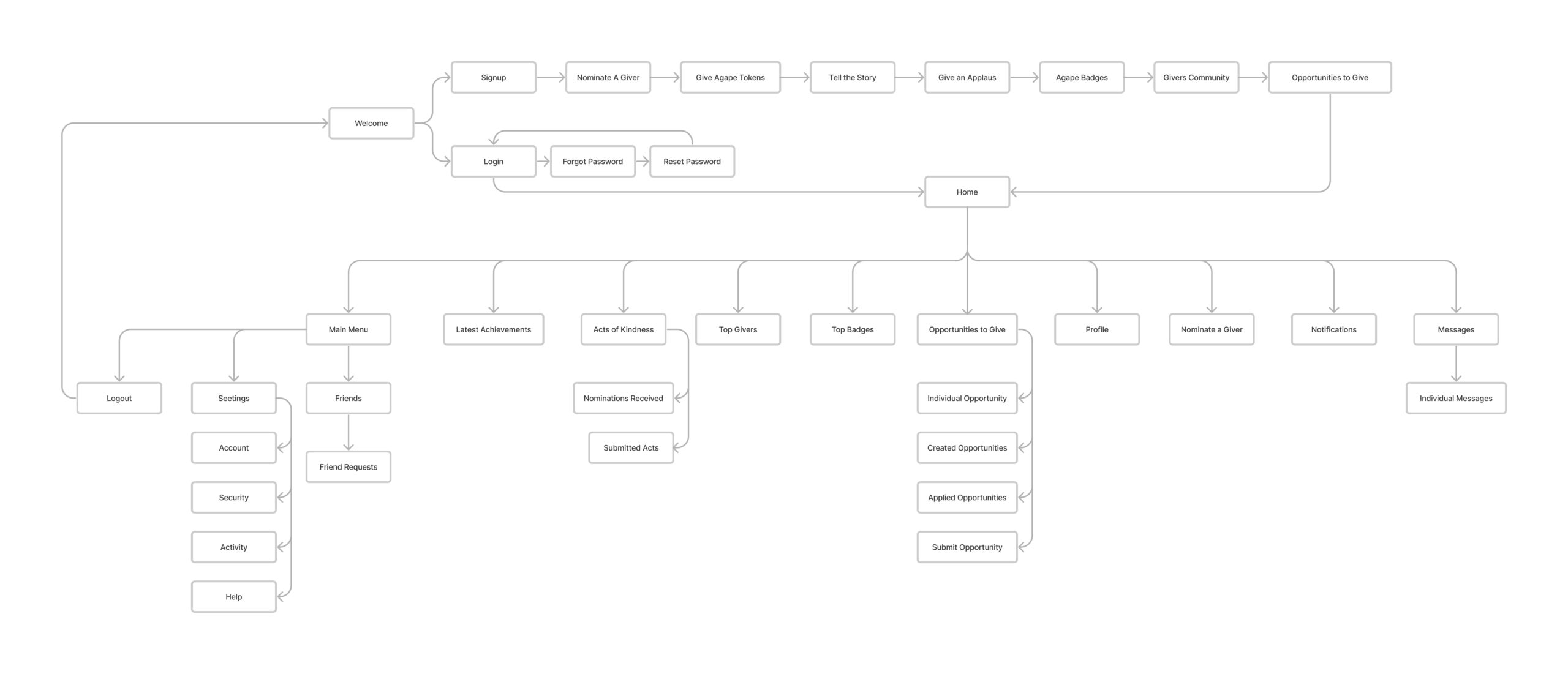
Task Flow Analysis
Develop
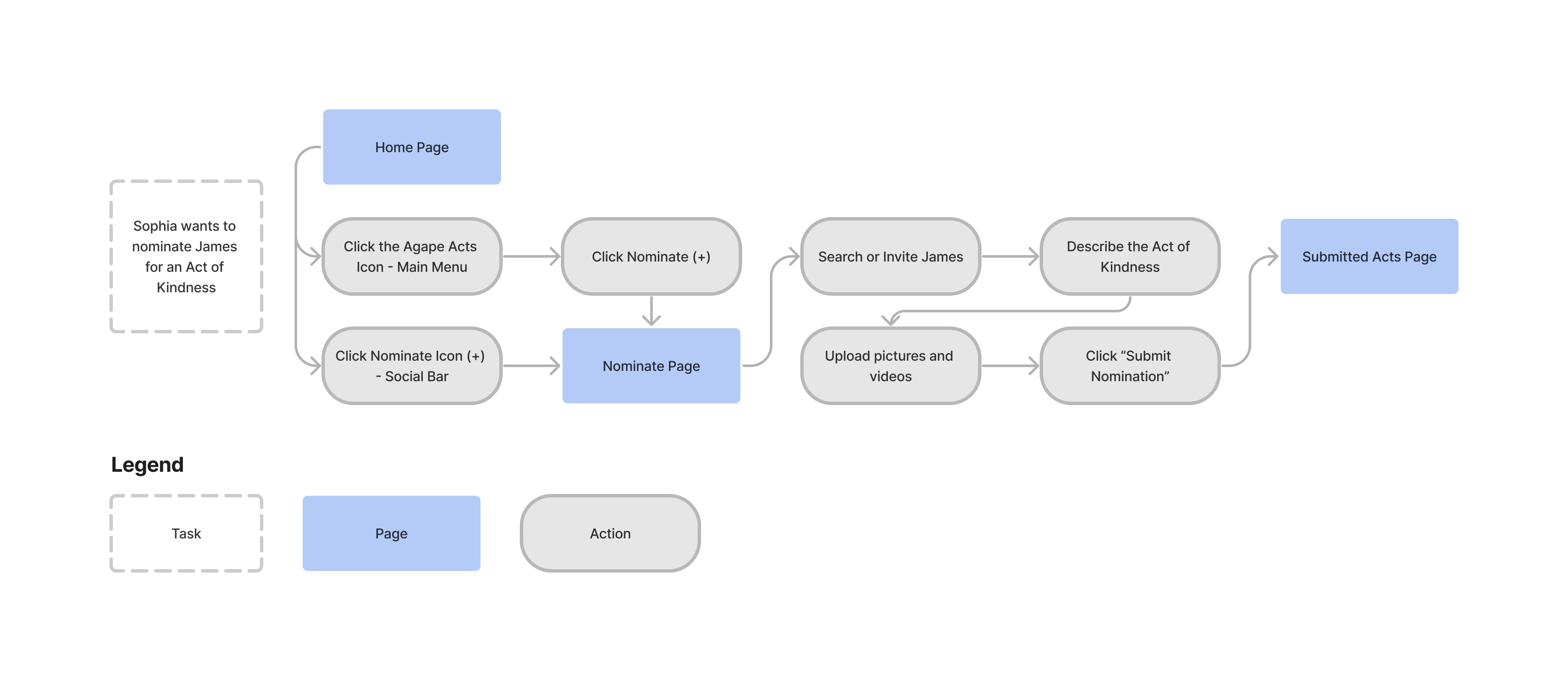
User Flow Development
Develop
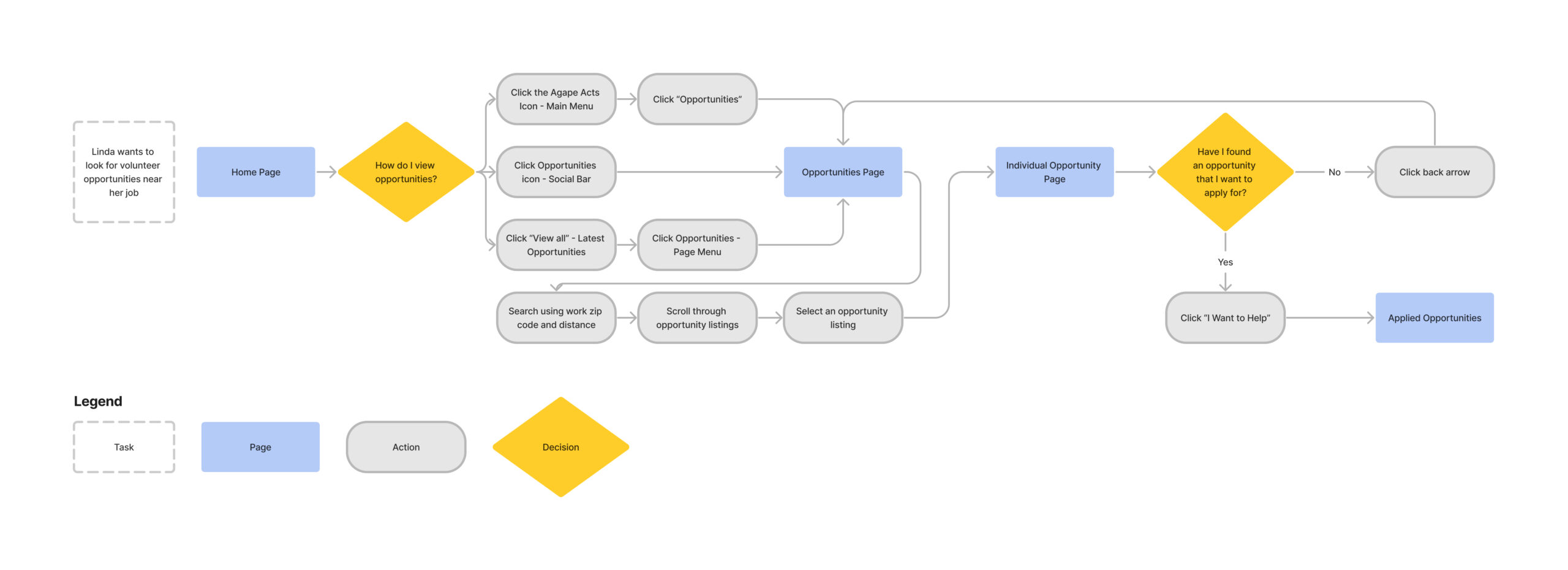
Wireframes
Develop
Low-Fidelity Wireframe




Mid-Fidelity Wireframe and Prototype
After establishing the visual direction of the layout, I transformed the low-fidelity wireframes into mid-fidelity wireframes. This phase focused on enhancing visual consistency and hierarchy before applying styles. The wireframes incorporated proven design patterns observed on competitor websites and addressed users’ goals, needs, frustrations, and motivations. Responsive wireframes were also developed to ensure a consistent experience across different devices. Once the essential task-oriented page designs were completed, I created a mid-fidelity prototype in Figma for usability testing. Testing the prototype at this stage helped identify information architecture and flow issues early on, saving time in the detailed design phase.

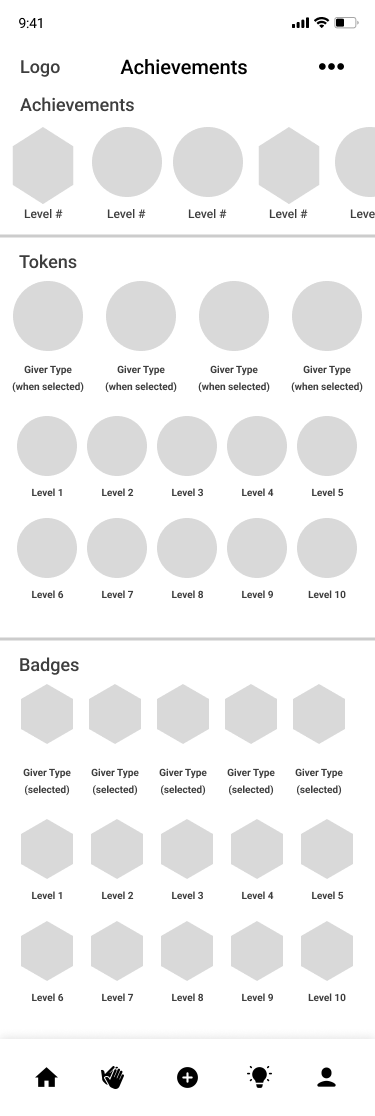

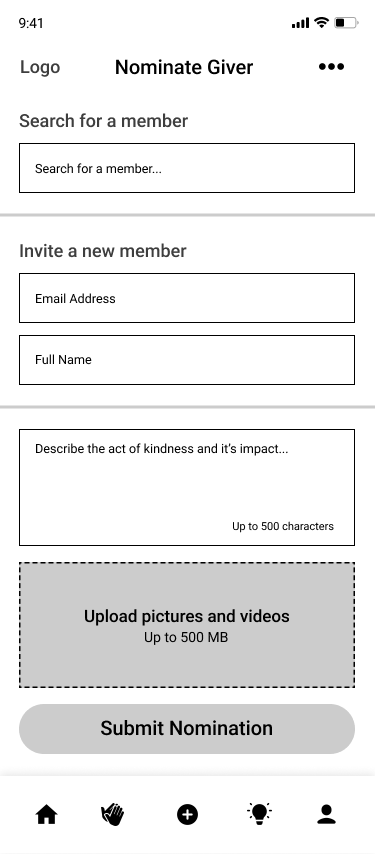
Usability Testing
Develop
Usability Test Plan
Conducting Usability Testing
Affinity Map
To summarize the usability testing results, I employed an affinity map. By assigning a unique color to each participant, I categorized observations into success, patterns, and frustrations. I focused on patterns shared by most participants and derived insights and recommendations from identified frustrations and patterns. These recommendations were ranked based on priority, allowing me to address key functions and enhance brand recognition.

Observation Patterns
Insight
Recommendation
Updates to Wireframes
Given our constraints in terms of time and resources, I prioritized revisions based on the recommendations outlined in the affinity map.

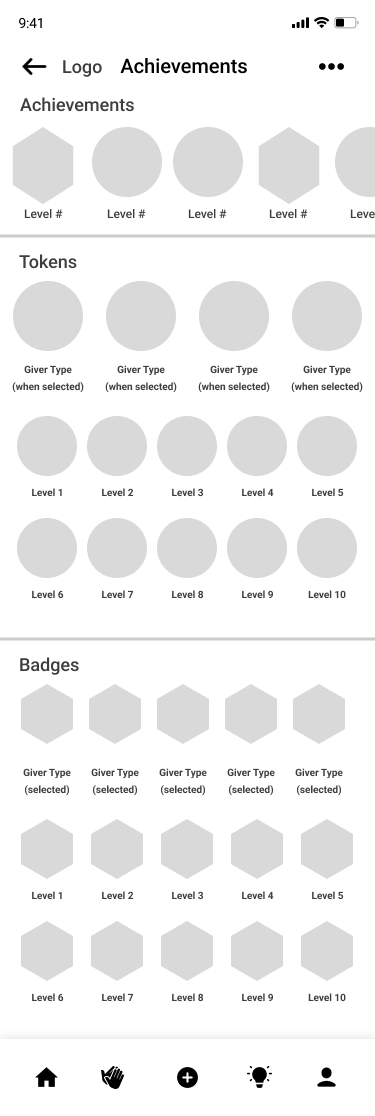


Mood Board
Deliver
To gather inspiration for Agape Acts, I created a mood board in Pinterest. I curated a selection of images that encapsulate the key attributes identified from our product goals and features. The goal was to keep the number of attributes minimal, ensuring that Agape Acts’ brand stands out distinctly.
Kindness: Include images and visuals that evoke feelings of kindness, compassion, and empathy. It should capture the essence of acts of kindness and the positive impact they have on individuals and communities.
Community: Include images and visuals that reflect a sense of community, connection, and support. It should convey a welcoming and inclusive atmosphere where users feel encouraged to engage and share their stories.
Inspiration: Include images and visuals that inspire and uplift users, showcasing inspiring stories, images, and quotes related to acts of kindness. It should motivate users to make a difference and create a ripple effect of positivity.
Vibrant Colors: Incorporate a color palette that is vibrant, warm, and inviting. This can include shades of blues, greens, and yellows to convey a sense of optimism and positivity.
Human Connection: Include images and visuals that capture the human aspect of acts of kindness, emphasizing personal stories, interactions, and moments of connection. It should evoke a sense of warmth, empathy, and the power of genuine human connections.
Typography: The typography should be clear, legible, and friendly, aligning with the brand’s values of kindness and connection. Choose font weights that provide hierarchy and visual contrast, enabling important information to stand out while maintaining readability. The typography should be versatile and adaptable across various platforms and screen sizes to ensure a consistent and seamless user experience.
Logo and Icon
Deliver
Style Tile
Deliver
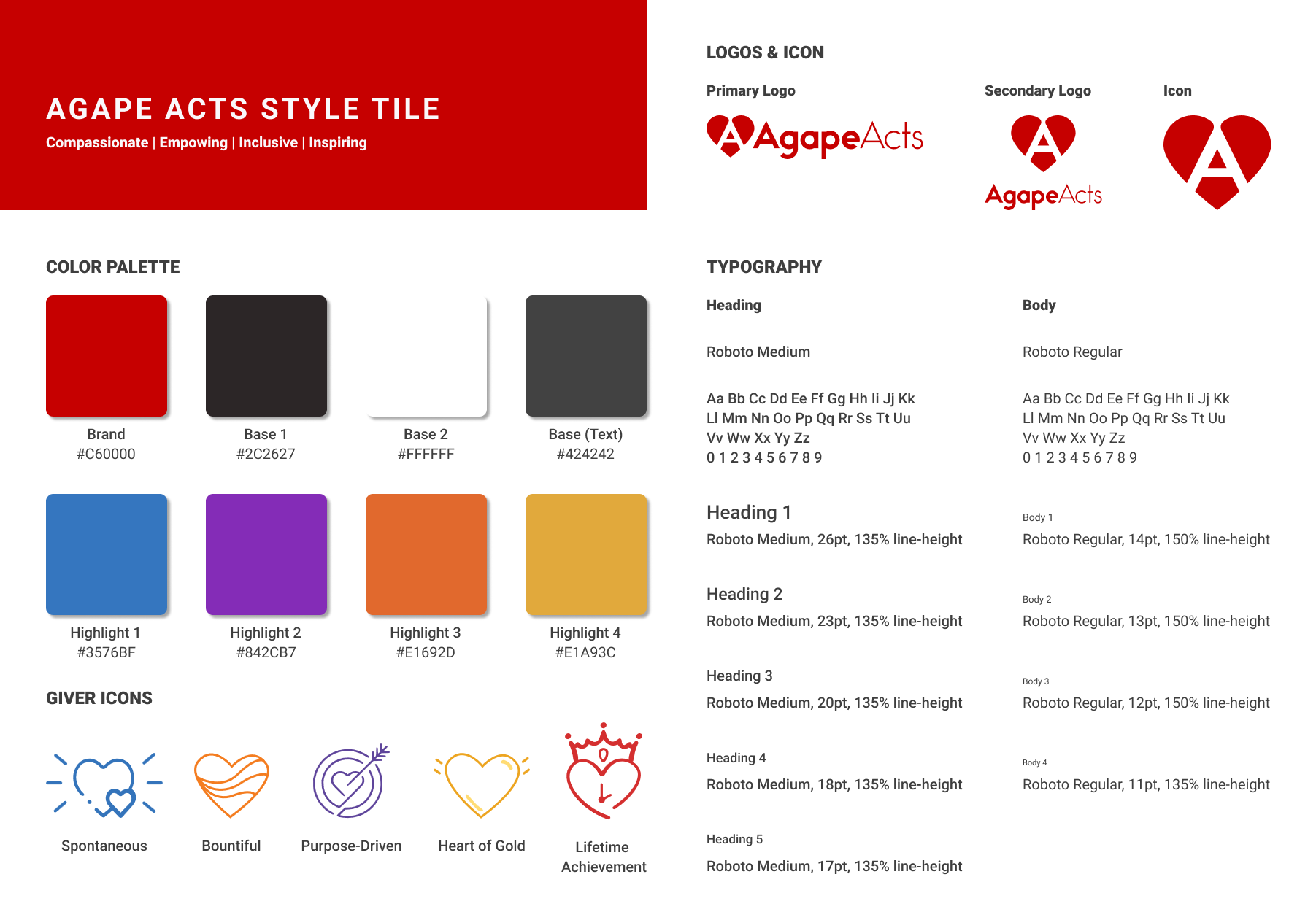
UI Kit
Deliver
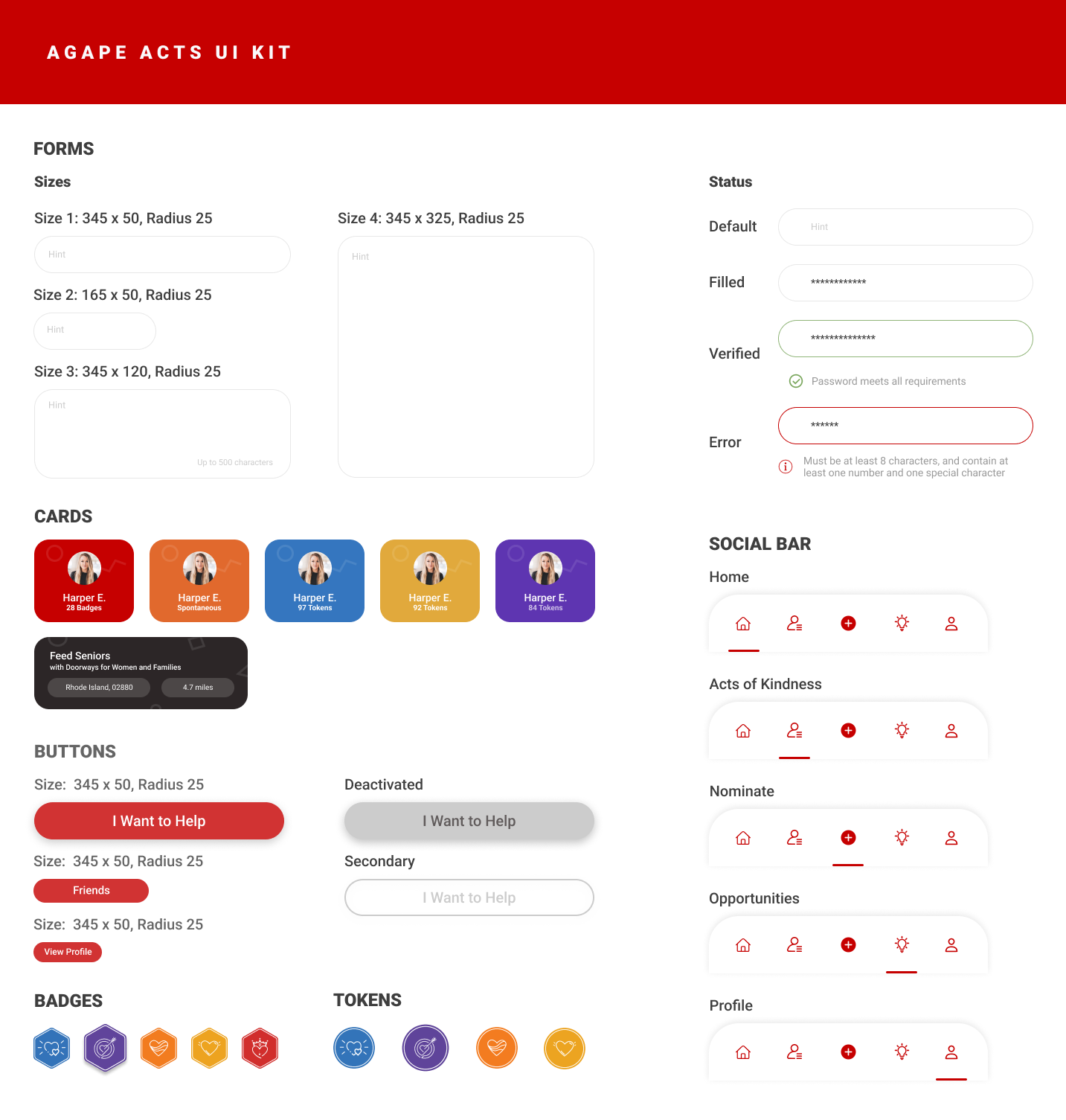
High-Fidelity Wireframe and Prototype
Deliver
I designed high-fidelity wireframes by applying established styles, creating responsive UIs. This allowed me to assess the app’s overall aesthetic and visual balance, ensuring a cohesive and appealing user experience. With all the high-fidelity pages designed, I used Figma to build the final prototype, which is a scaled-down version of the product. The prototype allows for interactive exploration and testing of the user interface and functionality.
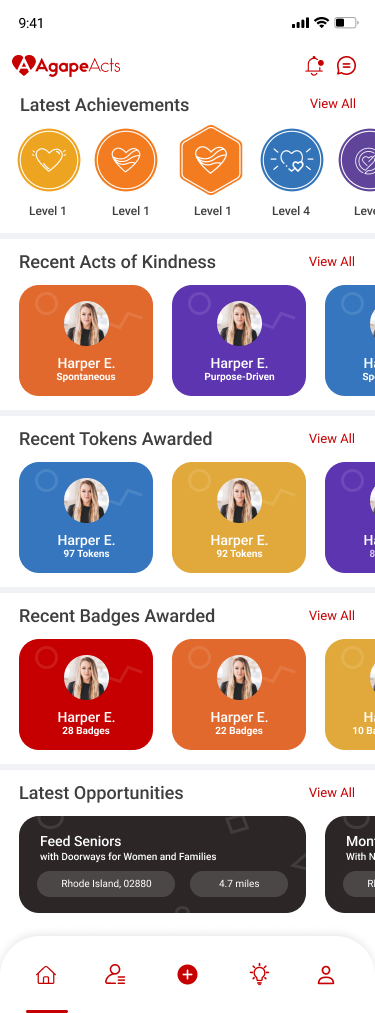
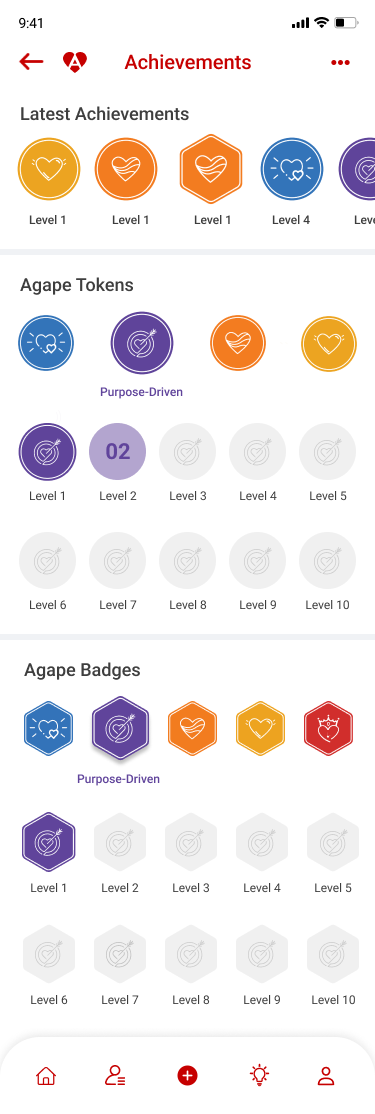
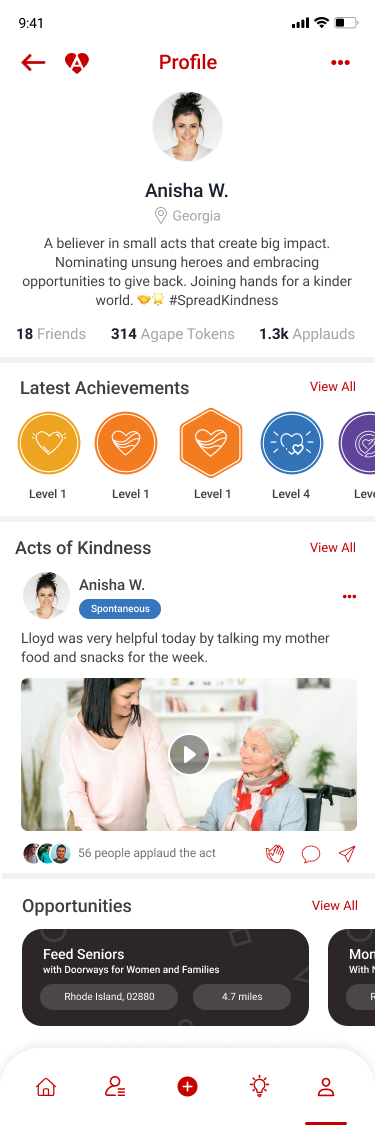
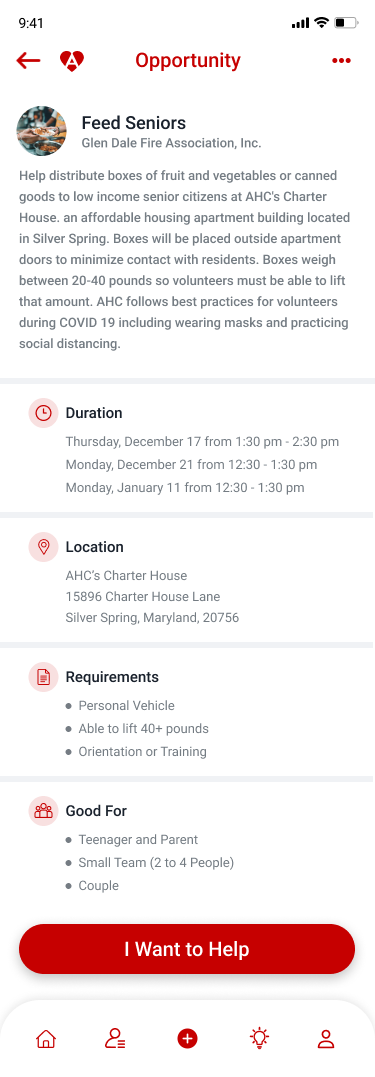
Final Thoughts
Reflections and Beyond
The Agape Acts project has been an exciting journey focused on creating an innovative and empowering mobile application that celebrates acts of kindness and fosters a positive and supportive community. Through thorough research, user interviews, and iterative design processes, we have developed a user-centered solution that addresses the needs and goals of our target audience. By incorporating features such as story sharing, community engagement, resource libraries, and cause support, Agape Acts aims to inspire, connect, and empower individuals to make a positive impact in the world.
Next Steps
With the completion of the initial phase of the Agape Acts project, there are several next steps to consider. These include:
Development and Testing: The UX design deliverables should be handed off to the development team for implementation. Conducting rigorous testing and gathering user feedback during the development phase will ensure that the app meets user expectations and functions smoothly across different devices and platforms.
Marketing and Launch: A comprehensive marketing strategy should be devised to promote Agape Acts and attract a wider user base. This may involve creating engaging content, social media campaigns, partnerships with relevant organizations, and targeted outreach to key stakeholders.
User Feedback and Iteration: Continuous user feedback should be collected to identify areas for improvement and gather insights on user satisfaction. This feedback will help inform future updates and iterations, ensuring that Agape Acts remains relevant and effective in meeting user needs.
Maintenance
To ensure the long-term success of Agape Acts, regular maintenance and updates are crucial. This includes:
Technical Maintenance: To ensure the smooth functioning of Agape Acts, regular monitoring of app performance is essential. This helps in promptly identifying and addressing any technical issues or bugs. Ongoing optimization is done to enhance the app’s performance, responsiveness, and overall user experience. Conducting periodic security audits ensures that the app’s data protection measures remain up to date. Collaboration with the development team allows for the implementation of necessary updates and bug fixes. Additionally, continuous testing on different devices and platforms guarantees compatibility and ensures a seamless user experience.
Content and Resource Management: Agape Acts aims to provide relevant and accurate content to its users. This involves keeping the app’s content and resources up to date, ensuring their ongoing relevance and accuracy. Staying informed about emerging trends, technologies, and user demands helps inform future updates and enhancements, keeping the app aligned with user expectations. Conducting regular user feedback sessions allows for valuable insights, identifying areas for improvement and addressing user concerns. Monitoring app store reviews and ratings enables the team to address user feedback effectively and continuously enhance the overall user experience.
User Engagement and Communication: Agape Acts values user engagement and aims to foster a strong sense of community. Continuous communication and engagement with the user community help create a feeling of involvement and gather valuable feedback. Regular marketing and promotional efforts are undertaken to attract new users and retain existing ones, ensuring a vibrant and active user base. Conducting periodic user surveys or interviews allows for a deeper understanding of evolving user needs and preferences, helping shape future updates and features. Lastly, responding to user inquiries and support requests in a timely and helpful manner ensures a positive user experience and user satisfaction.
In conclusion, the Agape Acts project has been a fulfilling endeavor aimed at creating an app that inspires kindness, fosters connection, and empowers users to make a difference. By prioritizing user needs, integrating innovative features, and maintaining a strong brand identity, Agape Acts has the potential to become a powerful platform that spreads positivity, gratitude, and compassion throughout the world.
Other Case Studies
HEALTH AND CLIMATE HUB
This case study focuses on the UX design process to create an engaging and user-friendly platform that provides a directory and encourages active involvement in health and environmental initiatives.
CLIMATE RESOURCES FOR HEALTH
DURATION
Project Scope
Website and Branding
DURATION
Project Scope
7 weeks (280 hours)
Website and Branding
HEALTH AND CLIMATE HUB
DURATION
(320 hours)
Project Scope
CLIMATE RESOURCES FOR HEALTH
DURATION
(280 hours)
